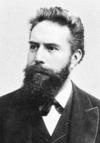- Röntgen, Wilhelm Conrad
-
or Wilhelm Conrad Roentgendied Feb. 10, 1923, Munich, Ger.German physicist.He taught at the Universities of Giessen (1879–88), Würzburg (1888–1900), and Berlin (1900–20). In 1895 he discovered rays that did not exhibit properties such as reflection or refraction and mistakenly thought they were unrelated to light. Because of their mysterious nature, he called them X rays. He later produced the first X-ray photographs, showing the interiors of metal objects and the bones in his wife's hand. He also did important research in a wide variety of other fields. In 1901 he was awarded the first Nobel Prize for Physics.
 RöntgenHistoria-Photo
RöntgenHistoria-Photo* * *
▪ German physicistborn March 27, 1845, Lennep, Prussia [now Remscheid, Ger.]died Feb. 10, 1923, Munich, Ger.German physicist who was a recipient of the first Nobel Prize for Physics, in 1901, for his discovery of X-rays (X-ray), which heralded the age of modern physics and revolutionized diagnostic medicine.Röntgen studied at the Polytechnic in Zürich and then was professor of physics at the universities of Strasbourg (1876–79), Giessen (1879–88), Würzburg (1888–1900), and Munich (1900–20). His research also included work on elasticity, capillary action of fluids, specific heats of gases, conduction of heat in crystals, absorption of heat by gases, and piezoelectricity.In 1895, while experimenting with electric current flow in a partially evacuated glass tube (cathode-ray tube), Röntgen observed that a nearby piece of barium platinocyanide gave off light when the tube was in operation. He theorized that when the cathode rays (electrons) struck the glass wall of the tube, some unknown radiation was formed that traveled across the room, struck the chemical, and caused the fluorescence. Further investigation revealed that paper, wood, and aluminum, among other materials, are transparent to this new form of radiation. He found that it affected photographic plates, and, since it did not noticeably exhibit any properties of light, such as reflection or refraction, he mistakenly thought the rays were unrelated to light. In view of its uncertain nature, he called the phenomenon X-radiation, though it also became known as Röntgen radiation. He took the first X-ray photographs, of the interiors of metal objects and of the bones in his wife's hand.Additional ReadingOtto Glasser, Wilhelm Conrad Röntgen and the Early History of the Roentgen Rays (1933, reissued 1993; originally published in German, 1931), focuses on the scientific events of 1856. W. Robert Nitske, The Life of Wilhelm Conrad Röntgen, Discoverer of the X Ray (1971), treats the personal and public aspects of his life.* * *
Universalium. 2010.
